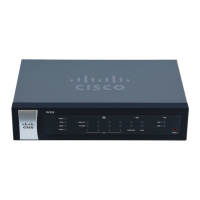Setup
Setup Network
18 Cisco RV320/RV325 Administration Guide
3
Adding or Editing an IPv4 Network
By default one IPv4 LAN subnetwork is configured, 192.168.1.1. One subnetwork is
usually sufficient for most small businesses. The firewall denies access if a LAN
device source IP address is on a subnetwork that is not specifically allowed. You
can allow traffic from other subnetworks and use this device as an edge router
that provides Internet connectivity to a network.
STEP 1 Click the IPv4 tab to display the Multiple Subnet table.
STEP 2 To add a subnetwork, click Add. IP Address and Subnet Mask fields display in the
columns. After you click Save, you can edit the subnetwork to be part of a VLAN,
manage IP addresses through the DHCP server, or set TFTP server parameters.
STEP 3 Enter the device IP Address and Subnet Mask.
STEP 4 Click Save to save your changes or click Cancel to undo them.
To edit a subnetwork, select the IPv4 subnetwork to be modified and click Edit.
The DHCP Setup section describes the process for modifying the subnetwork
parameters.
Editing the IPv6 Address Prefix
If you enabled Dual-Stack IP for the IP Mode, you can configure the IPv6 prefix.
To configure the IPv6 prefix, click the IPv6 tab, select the IPv6 prefix, and click
Edit. The default IP address is fc00::1, and the default prefix length is 7. The IPv6
tab is available only if Dual-Stack IP is enabled in the IP Mode table. The DHCP
Setup window appears.
WAN1 or WAN2 Port Settings
The WAN Setting table displays the interface, such as USB1, WAN1, or WAN2, and
connection type. The settings for the interfaces can be modified.
NOTE If you are running IPv6, select the IPv6 tab before selecting the WAN interface to
configure. Otherwise, the IPv6 parameters are not displayed in the WAN
Connections Settings window.

